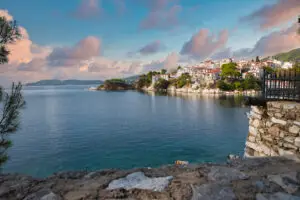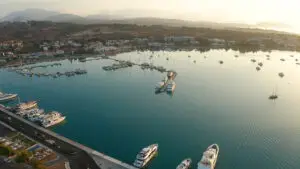
Rhodes, Greece – Sailing Through Myth, History & Hidden Harbors
Welcome to Rhodes Sailing to Rhodes The crown jewel of
Tucked away along the coast of the island of Evia (Euboea) in Greece, the anchorage of Ormos Skorponeri offers a peaceful stop-over for skippers navigating the region’s eastern and northern Aegean waters. Its relatively sheltered position and scenic shoreline make it a good choice for an overnight or rest anchorage, especially when you’re seeking something quieter than the busier marinas and anchorages.
While not a large or heavily developed harbour, the cove provides enough depth and holding in a calm situation for a sailing vessel to feel comfortable. That said, being mindful of wind direction and swell is essential given the open nature of the surroundings. For skippers operating a cruiser, sailing yacht or charter vessel, Ormos Skorponeri merits consideration with prudent planning, ideally as part of a route around the Evia coastline or en-route to the Northern Sporades or mainland ports.
In this guide we will provide practical information: coordinates for navigation, seabed characteristics, protection and exposure, approach tips, amenities, nearby sailing stops, community feedback and FAQs. Our focus is strictly skipper-oriented, helping you make an informed decision about whether this spot suits your vessel, crew and schedule.
Coordinates: approx. 38°30’20.3″N 23°21’06.3″E
Seabed / Holding: sand and sea-grass.
Depth range: generally around 4-10 m in the anchoring zone.
Protection: fair from prevailing northerly and westerly winds; exposed to strong southerlies and possibly swell from the open sea.
Ormos Skorponeri offers moderate shelter, but it is not a fully enclosed bay. When the wind comes from the south or south-east, the entrance and outer portion of the anchorage can be subject to swell and wave action. Make sure to check weather forecasts and local wind forecasts (especially for meltemi or seasonal gusts) before committing.
The bottom is described as a mixture of sand and sea-grass. Holding is generally acceptable for a moderate size yacht, but given the presence of sea-grass you should ensure your anchor has good bite and that you scope adequately (3:1 to 4:1 or more depending on conditions). The depth around the preferred anchoring area sits around 4-10 m, which makes it suitable for many monohulls and catamarans, though large deep-draft vessels may need to check clearance. Boats should monitor their swinging circle and ensure adequate space from the shore and other anchored craft.
Approach the bay at slow speed, ideally in daylight, to visually assess seabed colour and any hazards.
Stay central when entering and avoid cutting too close to the shore where rocks or shallows may lie.
Seek a spot somewhat off the beach but within good swing clearance and anchor away from obvious debris or crowded areas.
Monitor wind changes — if the wind shifts to a direction that opens the bay, be prepared to re-anchor or depart.
Have a backup plan for relocating if the exposure increases at night.
Limited shore facilities are listed; there is no marina or full-service harbour at this anchorage.
Shore access appears possible by dinghy or tender, but amenities such as water, fuel, electricity, restaurants or stores are not clearly listed and may be minimal or absent.
As such: bring provisions, water and fuel if you anticipate staying overnight or longer.
From Ormos Skorponeri you have options for onward sailing:
Head south or south-west along Evia’s coast toward “Karystos” and the southern tip of the island for a more developed harbour stop.
Alternatively you may proceed north toward the northern end of Evia, then on to the mainland coast or the islands of the Northern Sporades.
If conditions allow, you could use this anchorage as a rest before departing into the open sea en-route to the Saronic islands (depending on your season and schedule).
Always check wind forecast and tidal/seismic conditions in this region of the Aegean before heading into more exposed stretches.
The publicly-available reference notes mention the anchorage being used and described, but there are no detailed user reviews visible in the source to allow full paraphrasing of feedback. The bottom line from the data: sailors indicate that the anchorage is quiet and suitable for a stop, but caution is emphasised about protection under adverse wind.
Is this anchorage suitable for a 12 m monohull?
Yes, a 12 m monohull can anchor here comfortably, given the depth (4-10 m) and seabed (sand/sea-grass). Ensure proper scope and check for sea-grass when setting.
Can I rely on full services ashore (water, fuel, dining)?
No, services are minimal or unconfirmed. Plan to carry essential provisions, water, fuel and any spare parts you may need.
How is the protection from winds?
The anchorage is reasonably protected from northerly and westerly winds, but open to stronger south or east winds and some swell — monitor forecasts carefully and have an exit strategy.
Is night anchoring safe here?
Yes, provided you monitor weather changes, set a good anchor, mark your position, and ensure adequate length of scope and swing room. If winds change and become unfavourable, relocation may be wise.
What approach navigation hazards should I watch?
Approach slowly, check for shallows near the shoreline, watch for sea-grass beds (which may reduce holding) and avoid anchoring too close to the shore or other boats.
Is it crowded in peak season?
Based on available information, it appears quieter than high-traffic charter anchorages — but still have a berth plan in mind, especially during summer when Greek island traffic increases.
Are there alternative anchorages nearby if conditions worsen?
Yes — you should identify a nearby harbour or more sheltered bay (on the opposite side of Evia or the mainland) as backup before committing the night.
What is the seabed like for dragging risk?
Holding in sand and sea-grass is good, but dragging risk increases if wind or swell picks up. Use an anchor alarm/watch and consider adding a second anchor if conditions deteriorate.
Can catamarans anchor here safely?
Yes — the depth and seabed permit anchoring, but catamarans should check for space and swing clearance, plus protection from wind shifts (which can cause uncomfortable sideways movement).
Is there mobile or VHF coverage?
While likely there is mobile phone signal, you should not rely on full communications backup and should maintain standard safety protocol: VHF on channel 16, AIS where applicable, and a known anchor watch plan.
In summary, Ormos Skorponeri offers a worthy anchorage stop for skippers looking for a quieter, natural bay along Evia’s coast. With decent depths, acceptable holding and moderate protection, it can serve as a comfortable overnight or midday pause — so long as you respect the exposure and come prepared with self-sufficiency.
Before you commit: check the wind and swell forecast, ensure your anchor is well set, review your onward route and identify exit alternatives. If you wish, I can help you chart a full sailing itinerary around Evia, including recommended anchorages, marinas, fuel stops and provisioning. Would you like me to build that route for you now?

Welcome to Rhodes Sailing to Rhodes The crown jewel of

Sailing Route from Skiathos to Evia – The Quiet Passage

Contact Us Now to Create Your Dream Sailing Itinerary [email protected]